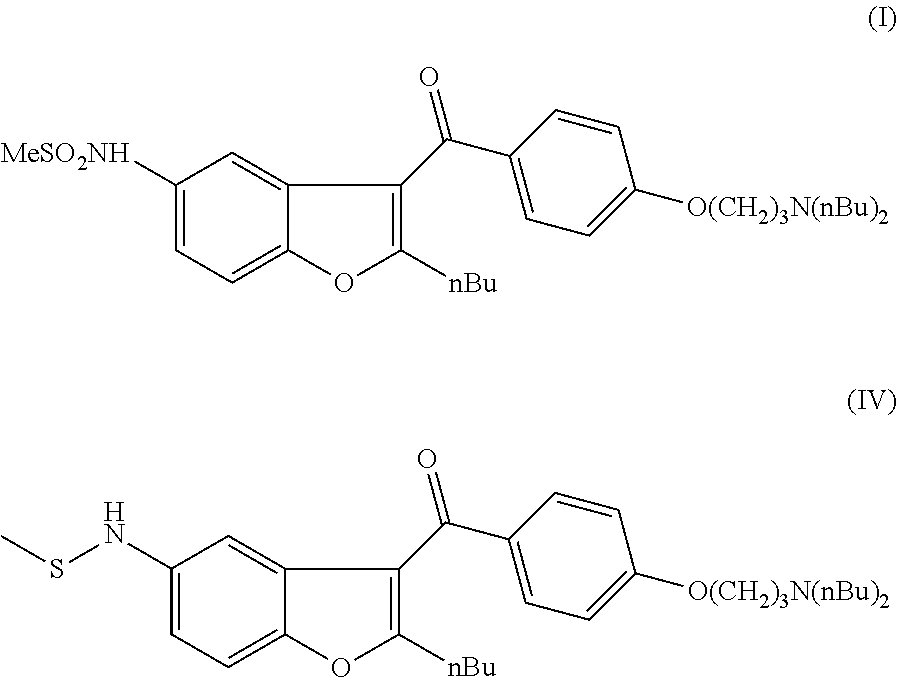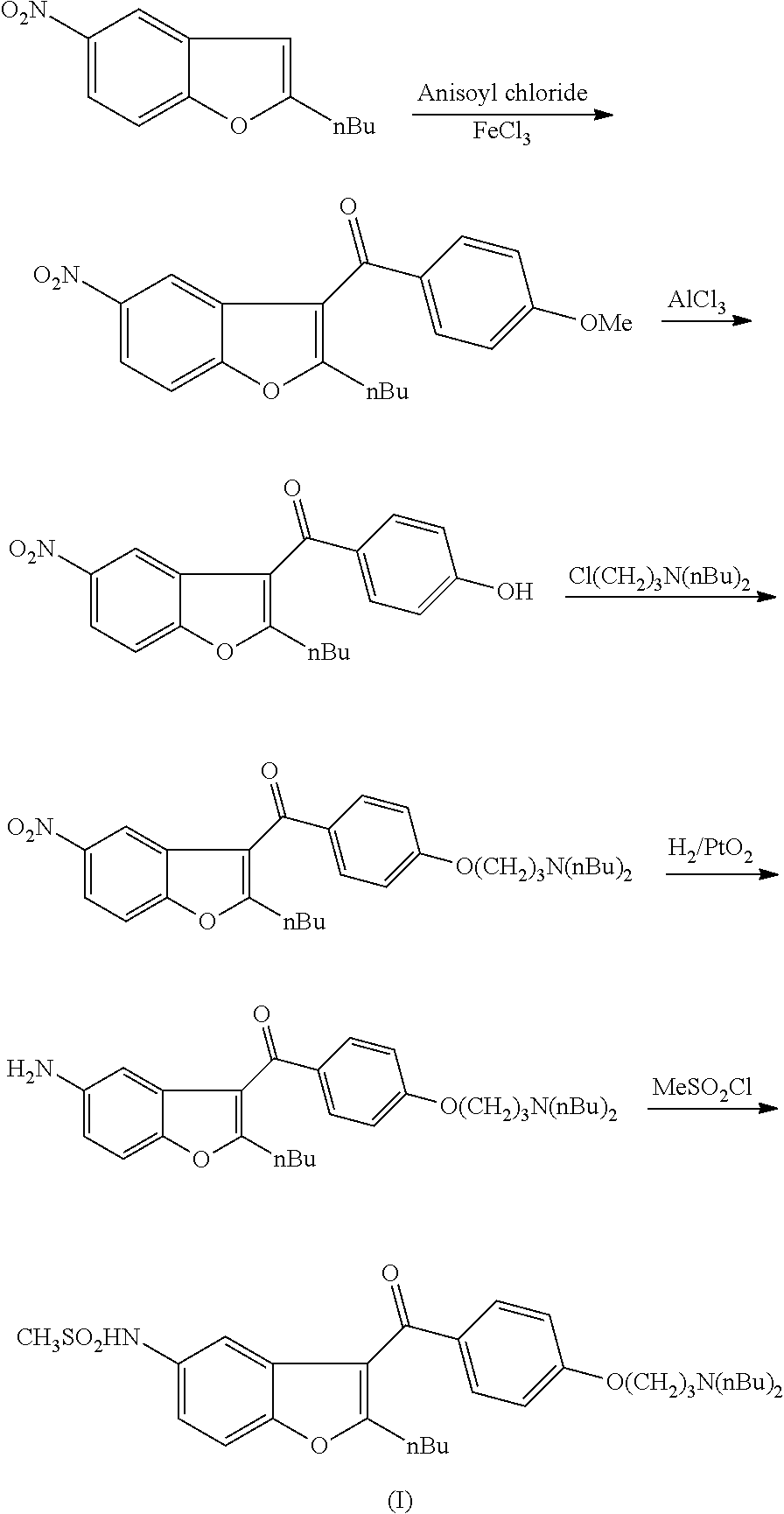Process for the preparation of dronedarone by oxidation of a sulphenyl group
a technology of oxidation and dronedarone, applied in the field of new products, can solve the problems of increasing the cost of preparation, less economical, and complicated industrial feasibility, and achieve the effect of improving isolation yield and being readily availabl
- Summary
- Abstract
- Description
- Claims
- Application Information
AI Technical Summary
Benefits of technology
Problems solved by technology
Method used
Image
Examples
example 1
(2-butyl-5-methylsulfanylamino-benzofuran-3-yl)-[4-(3-dibutylamino-propoxy)phenyl]-methanone (IV)
[0058]1.98 g of methanesulfenyl chloride (II) (0.024 mol, 1.2 eq; freshly prepared as described in the above mentioned literature), 9.57 g of (5-amino-2-butyl-benzofuran-3-yl)-[4-(3-dibutylamino-propoxy)-phenyl]-methanone (III) (0.02 mol, 1 eq) and 10 mL of 1.5 M sodium methylate methanolic solution were added into a flask and the mixture was diluted with 50 mL of methanol. The reaction mixture was stirred for 3 hours at room temperature. After the reaction was complete (followed by HPLC) the mixture was poured into 150 mL of water. The product was extracted with 2×60 mL of dichloromethane. The organic phase was washed with 50 mL of aq. NaHCO3 solution and then with 50 mL of water. The solvent was evaporated and the product was purified by column chromatography (column: spheric silica (60 Å); eluent: toluene:MTBE:methanol=50:40:10) to obtain 9.14 g of compound (IV) (87%) as a light yello...
example 2
(2-butyl-5-methylsulfanylamino-benzofuran-3-yl)-[4-(3-dibutylamino-propoxy)-phenyl]-methanone (IV)
[0062]4.78 g of (5-amino-2-butyl-benzofuran-3-yl)-[4-(3-dibutylamino-propoxy)-phenyl]-methanone (III) (0.01 mol, 1 eq) and 35 mL of pyridine were placed into a flask. The mixture was cooled down to 0° C. and 0.99 g of methanesulfenyl chloride (II) (0.012 mol, 1.2 eq; freshly prepared as described in the above mentioned literature) was added in 10 min. The mixture was stirred at 0° C. for 3 hours and then heated to room temperature and stirred for 6 hours. The mixture was poured into 100 mL of water. The product was extracted with 50 mL of dichloromethane. The organic phase was washed with 30 mL of water. The solvent was evaporated and the product was purified by column chromatography (column: spheric silica (60 Å); eluent: toluene:ethyl acetate=70:30) to obtain 2.2 g of compound (IV) (42%) as a light yellow oil.
[0063]Purity by HPLC: 98.1%.
[0064]The product was identical with the compoun...
example 3
N-[2-butyl-3-[4-[3-(dibutylamino)propoxy]benzoyl]-1-benzofuran-5-yl]-methanesulfonamide (I)
[0065]5.27 g of MCPBA (0.022 mol, 1.1 eq) and 10.49 g of (2-butyl-5-methylsulfanylamino-benzofuran-3-yl)-[4-(3-dibutylamino-propoxy)-phenyl]-methanone (IV) (0.02 mol, 1 eq) were dissolved in 90 mL of dichloromethane. The reaction mixture was stirred at room temperature for 4 hours. After the reaction was completed (followed by HPLC) 50 mL of 5% NaOH solution was added and the mixture was stirred for 30 min. The phases were separated and the aqueous phase was extracted with 30 mL of dichloromethane. The combined organic phase was washed with 50 mL of water, dried and concentrated. The crude product was purified by column chromatography (column: spheric silica (60 Å); eluent: toluene:ethyl acetate-70:30) to obtain 9.24 g of dronedarone (I) (83%).
[0066]Purity by HPLC: 99.7%.
[0067]1H NMR (DMSO): 7.77 (d, J=8.5 Hz, 2H); 7.27 (m, 3H); 6.91 (d, J=8.5 Hz, 2H); 5.52 (bs, 1H); 4.05 (t, J=6.0 Hz, 2H); 2....
PUM
| Property | Measurement | Unit |
|---|---|---|
| temperature | aaaaa | aaaaa |
| temperature | aaaaa | aaaaa |
| temperature | aaaaa | aaaaa |
Abstract
Description
Claims
Application Information
 Login to View More
Login to View More - R&D
- Intellectual Property
- Life Sciences
- Materials
- Tech Scout
- Unparalleled Data Quality
- Higher Quality Content
- 60% Fewer Hallucinations
Browse by: Latest US Patents, China's latest patents, Technical Efficacy Thesaurus, Application Domain, Technology Topic, Popular Technical Reports.
© 2025 PatSnap. All rights reserved.Legal|Privacy policy|Modern Slavery Act Transparency Statement|Sitemap|About US| Contact US: help@patsnap.com



